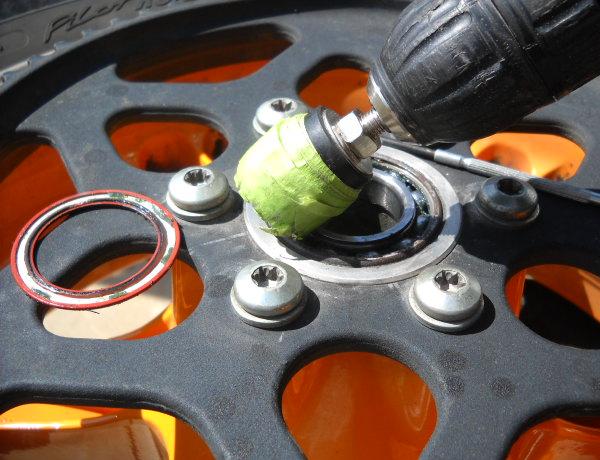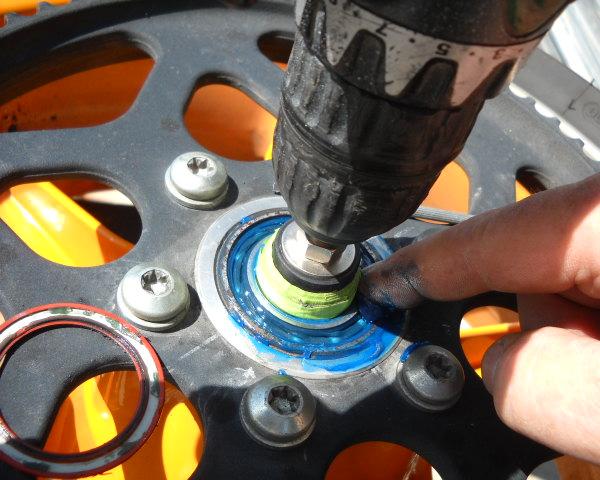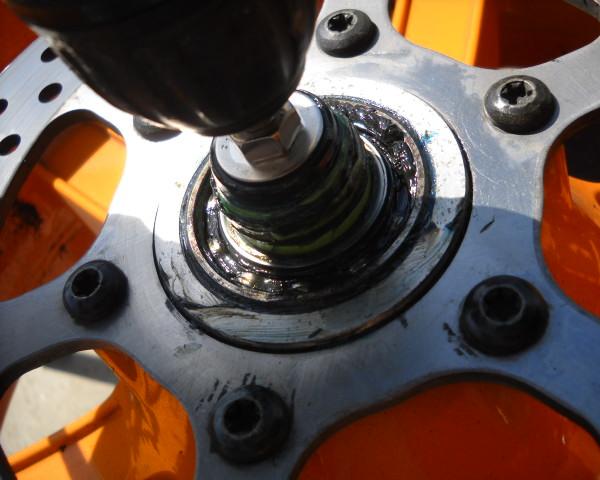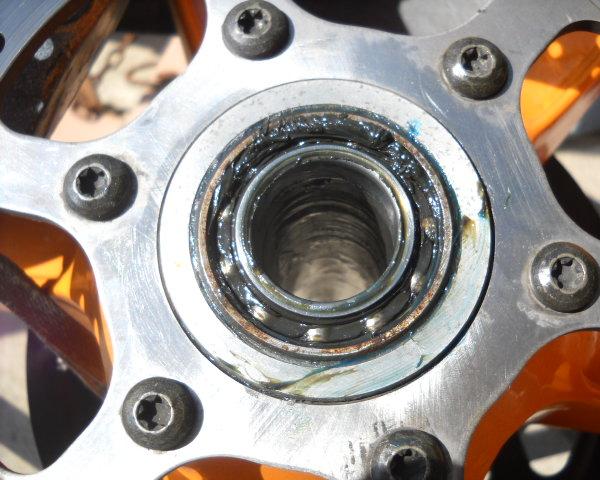| Author | Message | ||
Etennuly |
Since rear wheel bearings have been an issue, many of us have experimented with different ways to be sure a bearing is good.....and just importantly if it is bad. "It feels notchy" does not really mean much in some ways, because when they are in the wheel they can be quite hard to turn. So it was upon this sunny day I decided to make an apparatus that could help at least determine if the bearing's grease was repacking completely. Stuffing some in with a finger and turning it what little I could, was not satisfying my desire to really get it properly repacked. I filled my center hub with marine grease a while back, like when I put this set of bearings in something like 28,000 miles ago. Having a grease zerk fitting in the hub allows me to pump a shot in there to maintain fullness. I failed to allow the grease into the new bearings though. So any new bearings that I install, will have a small hole drilled on it's inner seal to allow pressurized fresh grease in. Here are some pictures of my set up. A drill, a rubber sanding hub, some masking tape to form a gripping seal to the bearing's inner race.  The tool, manly I know.  Whipping in new grease at a couple hundred RPM's, pretty blue stuff.  Uh-oh this grease not clean like other side!  Yucchy grease after repacking = bad bearing. This is a ZERO water intrusion bearing(at least 99%). It appears to have failed due to a lack of grease. The tiny amount they put in from the start is not enough. It turned a metallic black from it's parts eating each other. It is the left/brake side and I put orange seal bearings in it back when the new black one's were just coming out, everyone rushed to stock up and mine had failed, so only orange seal units were available. | ||
Etennuly |
Since I removed the bearing in question I tested how much grease they would take to have a sufficient amount and not worry about heat pushing it out. I believe the amount is three large gobs on the finger tip, one at a time, worked all of the way into the bearing. This will be enough to push the old grease out and make it fresh through the rolling assembly. I found that smearing grease on one side did not make it through to the other side, even with months of riding, thus the rotating of the bearing to work it through. So if you are into re-lubing the bearings on tire changes this spinning the grease in method really works. | ||
Natexlh1000 |
If you're going to have a pint of grease in the hub anyways, why not just remove the inner seals all together? | ||
Etennuly |
I did just that. Any grease that goes to the bearing from the inner side has to go through the small gap between the hub and the center spacer. So I just left the inner seals out. Spinning them is really a very effective way to get clean grease pumped through the bearing. | ||
Sharkguy |
This is a good idea I like it. I am a firm believer of repacking these. When I checked the rears on mine at 7000 miles there was very little grease present. These are the black seals. I have been regreasing them every 5000or so and they seem fine. This method will allow repacking without the hassle of wiping excess grease. Nice. I was just wondering if anyone has come up with a method to pre-load the bearings with the wheel off the bike. I used to do this on beemers to determine if bearings were good. A bearing can feel fine sometimes if it's not torques to specs but then fail once a load is applied. I guess checking while on the bike is the suggested method? | ||
Etennuly |
Actually when these bearings are under the torque load of the axle they should be in the static center of the ball's tracks with no side load. From what I am seeing failure is from two things. A lack of grease, and or water intrusion. I have had both now. In my last picture above the new grease pushed through to the back side of the bearing so that it looked full like the front side did. | ||
Hughlysses |
You could simulate the "squeeze" of the axle with a piece of allthread, some big flat washers, and nuts. Torque to ~50 ft-lbs, and it should be approximately equal to having the wheel installed. You'd have to spin the "axle" and both bearings at the same time, but it'd be interesting to see if notchy bearings feel smooth when you do this. | ||
Etennuly |
Hugh, even with using the proper installation technique for installing the bearings, mine turns both sides at the same time. It always has, every-time I have turned them with what ever bearings that were in there. Will yours allow you to turn only one? | ||
Hughlysses |
Vern- I haven't tried in so long I can't remember. I think you can turn the fronts individually at least. | ||
Uly_man |
"Hugh, even with using the proper installation technique for installing the bearings, mine turns both sides at the same time. It always has, every-time I have turned them with what ever bearings that were in there. Will yours allow you to turn only one?" I do not understand this? Or this. "Vern- I haven't tried in so long I can't remember. I think you can turn the fronts individually at least." Front and back wheels. The bearing outer ring should sit in the wheel hubs and not move with the wheel either on or off the bike. If they do your hub is worn out. You may, with the wheels off the bike, be able to spin either inner bearing ring as they are not "pulled up" on the spacer. With the wheels torqued up on the bike the inner rings should not be loose IE one spins and the other does not. If they do this your spacer is to short because it been over crushed. Is the problem either of these? | ||
Uly_man |
"It feels notchy - does not really mean much in some ways, because when they are in the wheel they can be quite hard to turn." I am afraid it does. If you can feel any "notch, grind" or anything else then the bearings are well shot on a XB. The problem, in my opinion, on this bike is the alloy spacer. Look at it this way. A billet block of alloy, over normal alloy, has been pressed (so denser) and will move less if pressed more. This bikes spacer is normal alloy and needs to be "pressed" (from new) to a certain point and no more. If it is not done right from new, or over crushed after, the bearing inner/outer rings will never be perfect and the result will be early bearing wear. And that is a engineering FACT. The point is that you can torque up the axle right but you will have no way of KNOWING AT ALL if the inner and outer bearing rings are in-line. And they MUST be perfect. The lateral offset is almost nothing. It is also possible, as the wheels are made in China, that the space between the bearings in the hub are not perfect either. (Message edited by uly_man on May 13, 2012) | ||
Etennuly |
Uly man, the bearing outer races are properly fit into the hub. They do not turn in the hub. As the second side's bearing is installed into the wheel, the inner race is the limiting factor for seating the outer race. When the inner race just touches the spacer, it is fit. At that point the hardened steel inner race touching the aluminum spacer will make it grip the aluminum just enough that it will turn the inner race of the bearing on the other side. As the axle shaft is tightened the left swing arm axle shoulder, the left inner race, the spacer, the right inner race, and the shoulder of the right side of the axle shaft all become one at approximately 50 ft lbs of tightening force. In a perfect World that will leave the balls of both bearings in the center of the track of the outer races. Then the pinch bolt on the right side is tightened to make the swing arm/ axle assembly become a single unit. If the bearings turn independently from each other without turning the spacer, one side or the other of the bearings are probably not seated quite far enough. Torquing the axle will push the inner race(s) in from that point, misaligning the balls. I have changed a lot of tires and several sets of wheel bearings on these XB's, and do not recall a rear bearing set that would turn freely and independently of the other side. The front bearings I have seen, all of them have turned easily. | ||
Uly_man |
Yes thank u. | ||
Etennuly |
 | ||
Rdkingryder |
I just replaced the rears on my 30K Ulysses.   | ||
Uly_man |
"I have changed a lot of tires and several sets of wheel bearings on these XB's, and do not recall a rear bearing set that would turn freely and independently of the other side." No E the new rears will not, old one may and fronts do, as you say. "I filled my center hub with marine grease a while back. It failed to allow the grease into the new bearings though. So any new bearings that I install, will have a small hole drilled on it's inner seal to allow pressurized fresh grease in." Which is why I thought it was an odd thing to do at the time you said about it. I do not think a small hole will work either as the grease is to thick. Also pumping in the grease will push the seal into/on the bearing/cage. Not good as you may get tiny ammouts of metal off the back of the seal and this could add to bearing wear. If you are going to do this I would leave the inner seal out altogether. |